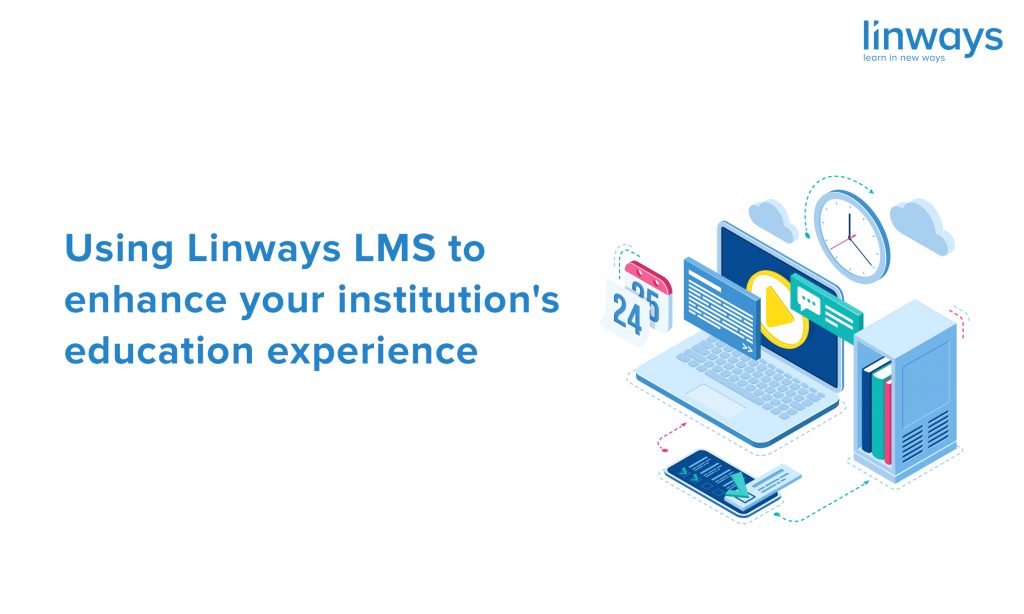
Linways LMS is a cloud-based academic management platform that helps teachers to streamline and simplify their daily academic activities. Linways is specifically designed with ease of use in mind. We’ve gone to great lengths to make sure that Linways AMS is easy to use, offers maximum functionality, and provide the best experience to its users while trying to improve their education’s quality.
The learning experience and environment play a huge role in shaping the outcomes. In the traditional classroom setup, teachers interact directly with their students face-to-face, and students interact with each other. This forms a community within the campus that builds and nurtures a very specific experience for the students. In online classrooms, however, the experience is not the same. It follows a different path and creates a different experience that is based on virtual interactions and individualistic learning patterns.
We are not to say one is better than the other because both models has their own perks and drawbacks. But if we were to blend the communal feeling with the digital learning space, the student-teacher interactions and peer learning can help institutions to maintain a quality-driven online learning experience.
With a powerful learning management platform like Linways LMS to support the teachers, institutions can easily create a better learning experience for the students and teachers in the digital space. Linways is essentially a virtual space which imitates the physical structure of a campus classroom. We will see what features of Linways specifically adds to this.
The students can experiment and experience what they have learned by listening to lectures using Linways LMS’ digital library, and the teachers can facilitate learning during live classes. Teacher can use interactive techniques and provides open-ended problems to solve using what the students have learned. And this would help teachers to assess and correct the errors in the thinking of students.
Linways LMS has a great admission module. Usually, admissions are this messy, time-consuming, and highly laborious tasks that takes weeks, if not months, to be fully complete. Institutions has to invite applications, make sure that the students would register, manage payments, shortlist eligible students, then collect their details, and finally create and allot batches to them, all before the classes begin. Usually this takes a team of faculty and managerial staff working day and night to make sure that everything goes smoothly. Still there are many instances where they somehow mess up. It may not be intentional, but we are after all, only human
To help academic institutions to simplify this admission process, Linways has a full-fledged admission module that let’s students apply online, register online, and make payments online. This takes a huge load off the staff’s shoulders that they don’t have to manually do everything. Creating and fixing the norms and forms once does it. Once the students have applied, the system will also shortlist them for the college based on previously set cutoff marks and rules.
Since Linways is primarily an Learning Management System, we always try to make sure that the core academics is never unnecessarily affected with the administration tasks. So to improve the overall quality, we’ve made the admission process smoother for your institution. Your staff can also split the eligible applicants into batches from the system and allot them classes from the system.
Course planner
Course planner is one of the core academic functions in our LMS. It enables the faculty to create plans for the entire semester/year and help them follow that course plan as the course progresses with actual plan. The course planner is also an important element for university reports, accreditation reports etc.
Here’s how it works. The faculty creates course plan, which include the modules, chapters, course delivery method, and the dates. It’s basically a calendar which says on this particular day, I’m going to take this chapter using this course delivery method. This is called a proposed plan. So when you look at the proposed plan, you get an overview about which areas of topics you are going to cover on a specific day. This helps the students to plan ahead and keep track of their curriculum.
The next step includes actual plan. This is a daily worklog about the course which the teacher updates. This will have the course details based on the proposed plan, and if the teacher completed the topics on a particular day as they’ve mentioned in the proposed plan, they mark complete in the actual plan. It they, for any reason, couldn’t, they mark incomplete, and they can simply extend that topic to another day. This helps the teacher to track the course, and see whether they are on schedule for the semester/year.
OBE
The Outcome Based Education is a learning theory that focuses on the outcomes or goals instead of results. The educators set a certain number of necessary skills and knowledge that the learner should possess at the end of education and they are identified as the outcomes. The assessments like exams, assignments, and projects are then defined to measure the achievement of these outcomes, and their results indicate whether the students has achieved them or not. Frameworks for accreditation like the NBA and NAAC bases their assessment on the OBE theory. We have done quite some research on this and have taken excessive critical feedback from many teachers just to make sure that Linways AMS has a usable and highly functional OBE module.
Our OBE module include
- options to create outcomes both program outcomes and course outcomes by higher authorities,
- detailed outcome attainment tracker to decide and fix contributions from different course outcomes to their program outcomes,
- a question paper creator to help faculty to map assessments to outcomes at the time of creating questions,
- and a full-fledged analytics for deep insights and specific attainment matrices.
Since OBE is a globally accepted learning paradigm, there is a high regard for it in the education community. But many are still cautious about implementing it because they think it’s complex and difficult to implement in an adaptive way. However, since we have done extensive research on the topic, our OBE management module for academic institutions is concise, easy for teachers to adapt to, and offers better insights into the whole attainment and tracking of outcomes. This also comes in handy when institutions are going for accreditation because they mandate OBE workflow as a quality benchmark. So institutions can easily adapt Linways LMS with it’s in-built, easy-t-use OBE module and make the whole process smoother.
Course material distribution is quite simple, and yet very powerful when it comes to academic quality improvement. It amounts to blended learning, a highly popular learning mechanism, and yet is so easy to adapt for our faculty. Students will not have to spend hours on finding and copying the correct course material if the teacher could simply share it to them through the academic management platform. The blended learning is essentially using both technology and offline teacher driven classroom interactions to complete the learning. Since the course materials are distributed through the system, students can easily revisit what they’ve learned from the classroom anytime, and can look up in advance on what they are going to learn in class.
So in effect, Linways LMS create a virtual campus and help teachers and the management to manage it efficiently. This allows to create an enhanced learning experience for the students and teachers. For more info about Linways LMS, check out our website or reach out to us for a guideed tour. We also publish blogs and articles on education, teaching tips, learning theories, education management, technology etc. Please subscribe to our mailing list if you would like to have our blogs delivered into your inbox.
Also published on Medium.




